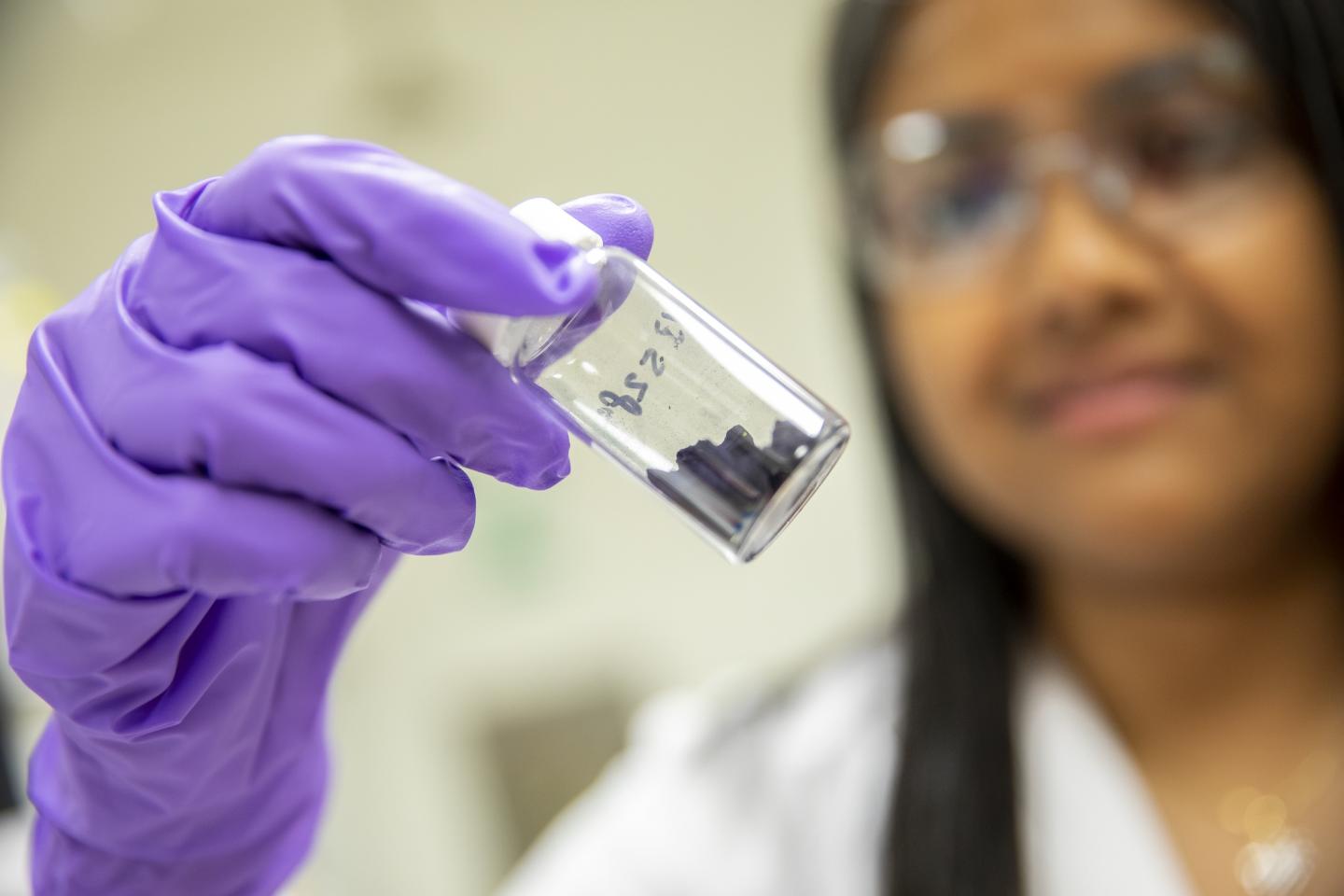A new platform for producing blue pigment could provide a sustainable alternative to conventional synthetic dyes and open the door for next-generation bioproduction

Credit: Marilyn Chung/Berkeley Lab
Often, the findings of fundamental scientific research are many steps away from a product that can be immediately brought to the public. But every once in a while, opportunity makes an early appearance.
Such was the case for a team from the Department of Energy’s Joint BioEnergy Institute (JBEI), whose outside-the-box thinking when investigating microbe-based biomanufacturing led straight to an eco-friendly production platform for a blue pigment called indigoidine. With a similar vividly saturated hue as synthetic indigo, a dye used around the world to color denim and many other items, the team’s fungi-produced indigoidine could provide an alternative to a largely environmentally unfriendly process.
“Originally extracted from plants, most indigo used today is synthesized,” said lead researcher Aindrila Mukhopadhyay, who directs the Host Engineering team at JBEI. “These processes are efficient and inexpensive, but they often require toxic chemicals and generate a lot of dangerous waste. With our work we now have a way to efficiently produce a blue pigment that uses inexpensive, sustainable carbon sources instead of harsh precursors. And so far, the platform checks many of the boxes in its promise to be scaled-up for commercial markets.”
Importantly, these commercial markets already have considerable demand for what the scientists hope to supply. After meeting with many key stakeholders in the textile industry, the team found that many companies are eager for more sustainably sourced pigments because customers are increasingly aware of the impacts of conventional dyes. “There seems to be a shift in society toward wanting better processes for creating everyday products,” said Maren Wehrs, a graduate student at JBEI and first author of the paper describing the discovery, now published in Green Chemistry. “That’s exactly what JBEI is trying to do, using tools derived from biological systems – it just so happens that our engineered biological platform worked very well.”
The story began when the team set out to test how well a hardy fungi species called Rhodosporidium toruloides could express nonribosomal peptide synthetases (NRPSs) – large enzymes that bacteria and fungi use to assemble important compounds. The scientists examined this fungi’s NRPS expression capability by inserting a bacterial NRPS into its genome. They chose an NRPS that converts two amino acid molecules into indigoidine – a blue pigment – to make it easy to tell if the strain engineering had worked. Quite simply, when it did, the culture would turn blue.
Going into this experiment, indigoidine itself was not the main interest for the team. Instead, they were focused on the larger picture: exploring how the assembly line functionality of these enzymes could be harnessed to create biosynthetic manufacturing pathways for valuable organic compounds, such as biofuels, and assessing whether or not the fungi represented a good host species for the production of these compounds. But when they cultivated their engineered strain, and saw just how blue the culture was, they knew something incredible had happened.
With an average titer of 86 grams of indigoidine per liter of bioreactor culture, the yield of the strain – which they named Bluebelle – is by far the highest that has ever been reported. (Other research groups, including the JBEI team, have synthesized indigoidine using different host microbes.) Adding to the weight of the achievement, the record-breaking yield was obtained from a culture process that uses nutrient and precursor inputs sourced from sustainable plant material. Previous pathways required considerably more expensive inputs yet made about one tenth the amount of indigoidine.
Beyond the potential applications of indigoidine, the study succeeded in its original goal of providing a potential production pathway for other NRPSs – something that is much more valuable than any single product. These complex enzymes have multiple subunits that each perform a distinct and predictable action in assembling a compound out of smaller molecules. Scientists at JBEI and beyond are keen to engineer enzymes that use NRPSs’ Lego block-like features to produce advanced bioproducts that are currently hard to make.
“A big challenge is to get a microbe to efficiently express such enzymes. This host has huge potential to fulfill that need,” said Mukhopadhyay.
The team’s next steps will be to characterize how indigoidine could be used as a dye and to dig deeper into the capabilities of R. toruloides.
###
This work was made possible by the expertise of multiple groups, including John Gladden from Sandia National Laboratories, who leads JBEI’s Fungal Biotechnology team, and Berkeley Lab’s Advanced Biofuels and Bioproducts Process Development Unit (ABPDU). The other researchers included Yuzhong Liu, Lukas Platz, Jan-Philip Prahl, Jadie Moon, Gabriella Papa, Eric Sundstrom, Gina Geiselman, Deepti Tanjore, Todd Pray, Jay Keasling, and Blake Simmons. JBEI is funded by the Department of Energy Office of Science. ABPDU is funded by the DOE Office of Energy Efficiency and Renewable Energy.
Founded in 1931 on the belief that the biggest scientific challenges are best addressed by teams, Lawrence Berkeley National Laboratory and its scientists have been recognized with 13 Nobel Prizes. Today, Berkeley Lab researchers develop sustainable energy and environmental solutions, create useful new materials, advance the frontiers of computing, and probe the mysteries of life, matter, and the universe. Scientists from around the world rely on the Lab’s facilities for their own discovery science. Berkeley Lab is a multiprogram national laboratory, managed by the University of California for the U.S. Department of Energy’s Office of Science.
DOE’s Office of Science is the single largest supporter of basic research in the physical sciences in the United States, and is working to address some of the most pressing challenges of our time. For more information, please visit science.energy.gov.
Media Contact
Aliyah Kovner
[email protected]
Original Source
https:/
Related Journal Article
http://dx.



